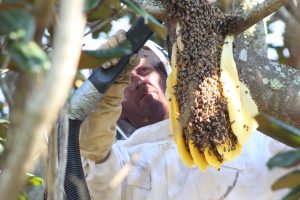Story and Photos By Sean Minton
“Taxidermy is how I make a living; beekeeping is my passion.” – Chad Cooper

Beekeeper Chad Cooper climbs up the magnolia tree located between building 7 and 8 and safely transfers the bees from their hive into a vacuum to relocate them to a different environment. His wife, Beth and father assist him in the process.

Cooper uses pheromones on the hive to relax the bees in order for insects to remain claim during the extraction process. Without the smoke, the bees would sting Cooper.

Hundreds of bees were spotted on campus in a nest they have been building since early spring of 2017. Cooper was called by the school to relocate the colony to a better suited area.

Mary Mabins and Rhonda Basler from the PSC marketing department watch Cooper remove the nest. While it may seem dangerous, Cooper says that the colony is docile and will not harm anyone unless the nest is attacked.

Cooper explains the process of the bees being transferred from the vacuum into the box. The box itself regulates how much air pressure gets inside.

The frame in the box is used to keep the bees from suffocating. Without the frame the bees would die. Once Cooper is done vacuuming, the colony will be then be placed into a new habitat. To do this, Cooper will remove the slide from the bottom of the vent to shift the bees into a safe apiary.

Beth Cooper inserts a piece of the removed beehive with brood into a frame. Brood are the embryos and larvae that are inside the honeycomb.

